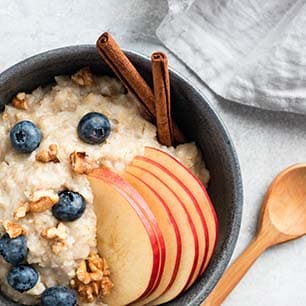
Updated December 26, 2025
It’s time to raise awareness about taking care of your heart. Dietary and lifestyle choices can make a big difference in heart health—and making changes is not as hard as you think. Try our heart-smart tips for simple, effective shifts in food choices that may have long-term benefits.
Fast facts about heart disease.
- Nearly half of all Americans (47%) fall into at least one of the three key heart disease risk factor categories: high blood pressure, high LDL cholesterol, and smoking.1
- Heart disease is the leading cause of death for both men and women.2
- Nearly 1 in 5 deaths are attributed to heart disease. 2
Eating for heart health.
Your overall eating pattern matters for your heart health. A diet emphasizing the intake of vegetables, fruits, nuts, whole grains, fish, and lean protein, and minimizing the intake of trans fats, red meat and processed meats, refined carbohydrates, and sweetened beverages is recommended to maintain heart health—including blood pressure and cholesterol levels. Check out these tips to get you on the right track.3
1. Load up on produce.
How much? Fruits and vegetables are great ways to get fiber. Federal guidelines recommend at least 2 cups per day of fruit4 and 2.5 cups per day of vegetables.5 Learn more about the amount that is right for you.
Looking for inventive ways to get more fruits and veggies? Add mushrooms to your favorite meatloaf recipe. Mushrooms provide fiber and a meaty texture. Try our Savory Turkey Meatloaf.
Go spiral. Revamp your favorite pasta dishes with spaghetti squash or spiralized vegetables. Make it colorful with spiralized zucchini and butternut squash.
Enjoy our twist on a classic with Lentil Bolognese over Zoodles.
Blend right in. Serve fruits and vegetables in an array of soups, such as our Apple-Sweet Potato Soup with Apple Yogurt Topper and Grilled Peach Gazpacho. Check out our refreshing Peach-Mango Protein Smoothies, or dream up your own concoction.
Riced is nice. Riced cauliflower makes a subtle, savory addition to many meals, such as salads and meal bowls. Try it in our tasty Pork Chili Rancho recipe.
2. Gather whole grains.
The 2020–2025 USDA Dietary Guidelines for Americans recommends making half your grains whole grains.6
Quick tips for adding whole grains.
Whether you’re craving something sweet or savory, there are many delicious meals that include oats. Oats are a source of whole grains, and they also contain soluble fiber, which may help lower blood cholesterol levels.7
Our Savory Turkey Meatloaf with Berry Salad and Oat-Almond Crumble is the perfect heart-smart meal for your family.
Sweeten your breakfast with our Blueberry-Oat Waffles. Check out more ideas for getting whole grains.
3. Legumes for days.
How much? The 2020–2025 USDA Dietary Guidelines for Americans recommends 1–3 cups per week of beans, peas, and lentils.8 Legumes are another great way to get soluble fiber. 7
Here are some great ideas for adding more legumes, or pulses, into your diet.
4. Select smart proteins.
Take these ideas to heart to enjoy proteins with less saturated fat.
- Select cuts of beef and pork with round or loin in the name, such as sirloin, tenderloin, or top round steak.9
- Choose skinless poultry or remove the skin before eating. Our Coconut-Turmeric Chicken Skillet with Rice features boneless, skinless chicken breasts.
- Cooking methods matter. Grill, broil, roast, or bake meats and poultry rather than frying them.9 Choose skinless poultry or remove the skin before eating. Try our One Pan Lemon-Olive Chicken with Couscous for a Mediterranean-inspired meal. Chicken is sautéed with couscous, spices, and lemon.
5. Get nutty.
Consuming more nuts may help lower the risk of heart disease.10 In fact, eating a handful of nuts a day (about 1/4 cup) is a great habit for heart health.11
6. Fish for fatty acids.
Fatty fish, including salmon, trout, oysters, crab, mussels, catfish, clams, and flounder, offer long-chain omega-3 polyunsaturated fatty acids called EPA and DHA.12
How much? The American Heart Association recommends eating 2 servings of fish (particularly fatty fish) per week.11 A serving is 3.5 ounces cooked, or about 3/4 cup of flaked fish.13
Catch the benefits of seafood and read more about omega-3s in seafood.
7. Cut back on added sugars.
- Sweets may satisfy your taste buds, but it turns out they may not be good for the heart. In a study, researchers found an association between a high-sugar diet and a greater risk of dying from heart disease. Over the course of the 15-year study, people who ate 17% to 21% of their calories from added sugar had a 38% higher risk of dying from cardiovascular disease compared with those who consumed 8% of their calories as added sugar.14
- How much? The USDA Dietary Guidelines recommends less than 10% of your calories from added sugars.8
- Find out more about the types of sugar and how to reduce sugar in beverages.
Publix Health & Wellness.
Each wellness journey is uniquely personal. It’s about achieving your goals and feeling your best. Explore more dietitian-curated topics, resources, tips, and products that speak to you.
Sources
1 National Heart, Lung, and Blood Institute (NHLBI), National Institutes of Health. Coronary Heart Disease – Risk Factors. U.S. Department of Health & Human Services. August 10, 2015.
2 Centers for Disease Control and Prevention (CDC). Heart Disease Facts. U.S. Department of Health & Human Services. September 27, 2021.
3 American Heart Association. The American Heart Association Diet and Lifestyle Recommendations. December 11, 2024
4 American Heart Association. Fruits and Vegetables Serving Sizes Infographic. Accessed November 15, 2021.
5 American Heart Association. Fruits and Vegetables Serving Sizes Infographic. Accessed November 15, 2021.
6 U.S. Department of Agriculture. Grains. MyPlate.gov. Accessed November 15, 2021.
7 Mayo Foundation for Medical Education and Research (MFMER). Dietary Fiber: Essential for a Healthy Diet. Mayo Clinic. December 11, 2024.
8 U.S. Department of Agriculture & U.S. Department of Health and Human Services. Dietary Guidelines for Americans, 2020–2025, 9th ed. December 2020. Available at DietaryGuidelines.gov.
9 Meat, Poultry, and Fish: Picking Healthy Proteins. American Heart Association. August 28, 2024
10 Guasch-Ferré, Marta, PhD, Xioaran Liu, PhD, Vasanti S. Malik, PhD, Qi Sun, PhD, ScD, et al. Nut Consumption and Risk of Cardiovascular Disease. Journal of the American College of Cardiology 70, no. 20 (November 14, 2017): 2519–32. November 13, 2018.
11 4 Ways to Get Good Fats Infographic. American Heart Association. Accessed November 15, 2021.
12 Which Fish Is the Richest in Omega-3s? Seafood Nutrition Partnership. Accessed November 15, 2021.
13 Fish and Omega-3 Fatty Acids. American Heart Association. November 1, 2021.
14 Yang, Quanhe, Zefeng Zang, Edward W. Gregg, W. Dana Flanders, Robert Merritt, and Frank B. Hu. Added Sugar Intake and Cardiovascular Diseases Mortality Among US Adults. JAMA Internal Medicine 174, no. 4 (April 2014): 516–24.

 You are about to leave publix.com and enter the Instacart site that they operate and control. Publix’s delivery and curbside pickup item prices are higher than item prices in physical store locations. Prices are based on data collected in store and are subject to delays and errors. Fees, tips & taxes may apply. Subject to terms & availability. Publix Liquors orders cannot be combined with grocery delivery. Drink Responsibly. Be 21. For prescription delivery, log in to your pharmacy account by using the Publix Pharmacy app or visiting
You are about to leave publix.com and enter the Instacart site that they operate and control. Publix’s delivery and curbside pickup item prices are higher than item prices in physical store locations. Prices are based on data collected in store and are subject to delays and errors. Fees, tips & taxes may apply. Subject to terms & availability. Publix Liquors orders cannot be combined with grocery delivery. Drink Responsibly. Be 21. For prescription delivery, log in to your pharmacy account by using the Publix Pharmacy app or visiting 
